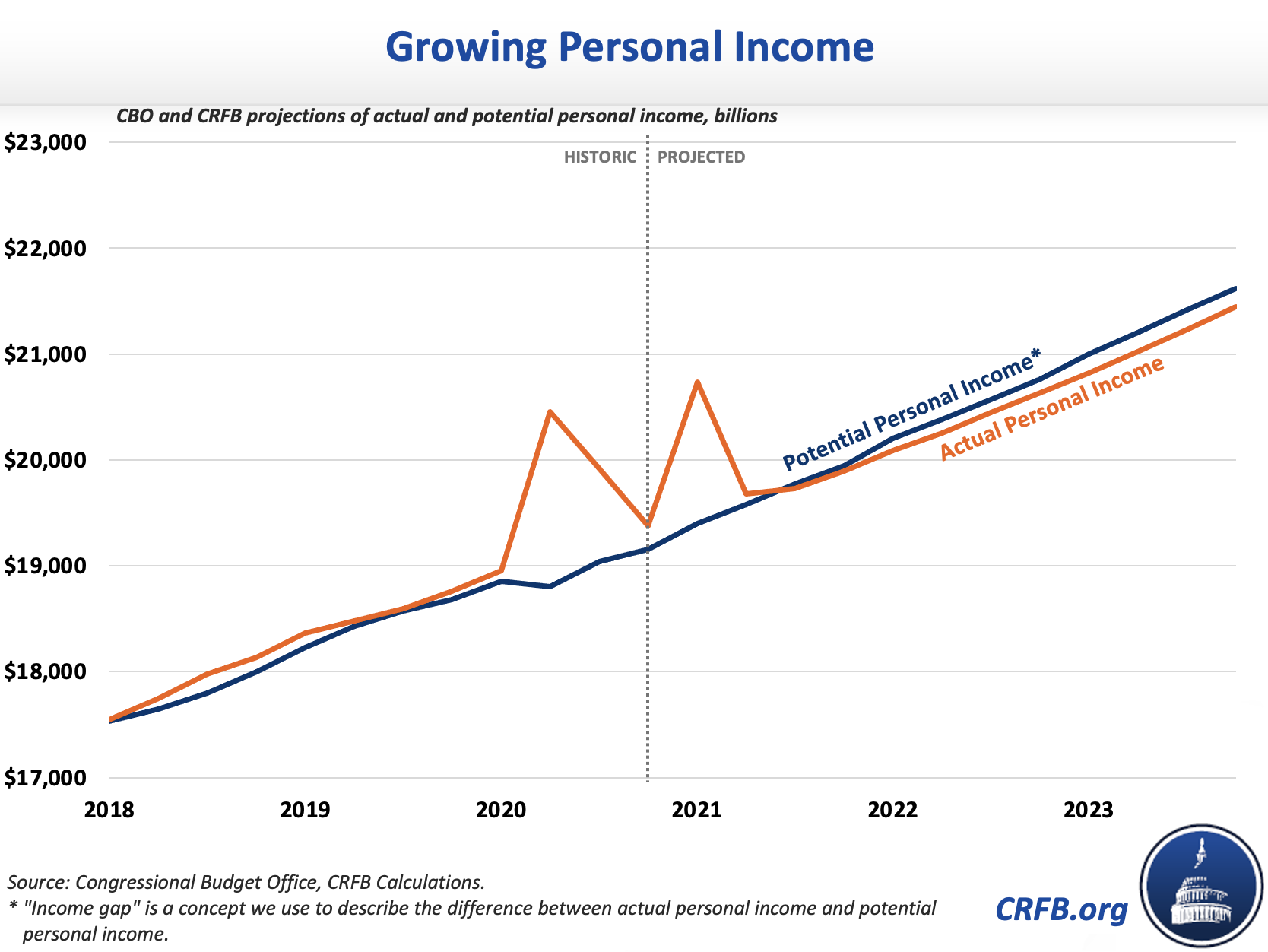America Faces a $380 Billion Output Gap
Today's economic projections from the Congressional Budget Office (CBO) show the economy is likely to experience a strong economic recovery, but continues to perform below its potential in the near-term. Thanks in part to the recently-enacted Response & Relief Act and the ongoing vaccination campaign, CBO estimates the economy will grow by 3.7 percent over the course of 2021 (Q4 to Q4) and will have mostly recovered by the end of 2023. In the interim, CBO estimates an output gap of $380 billion for the remainder of 2021, $600 billion through 2022, and $760 billion through the end of 2023. Based on CBO's estimates, it appears personal income will be about $250 billion below potential through 2023, on net.

The output gap measures the difference between expected economic activity as measured by Gross Domestic Product (GDP) under current law and possible economic output if the economy were operating at full potential — with full employment of workers and capital — and the pandemic were not stifling its performance.
In the second quarter of 2020 when the pandemic first arrived in the United States, CBO estimated that the economy was at risk of facing an output gap as large as 15 percent of potential GDP — more than $800 billion for just a quarter of the year. Thanks to an aggressive legislative response and stronger than anticipated economic performance, the actual gap ended up closer to 10 percent of potential GDP — or $550 billion — that quarter.
Since then, nearly $3 trillion of disbursed fiscal support and efforts to adapt to the pandemic have shrunk the output gap substantially to 4 percent in the third quarter of 2020, 3 percent by the fourth quarter, and a projected 2 percent, or $130 billion, this quarter. As more than $1 trillion of further fiscal support makes its way through the economy, CBO estimates the output gap will shrink to 1 percent by the beginning of next year and less than 0.5 percent by late 2023. Overall, CBO projections suggest the gap will total only 1.7 percent ($380 billion) for the rest of 2021 and 1.1 percent ($760 billion) over the next 3 years.1

It appears that the “income gap” — the difference between what personal income would normally be, based on potential GDP, and what it is as a proportion of actual GDP — is even smaller.2 Thanks in large part to unemployment benefits, recovery rebates, and other fiscal support, personal income this quarter is roughly 10 percent higher than before the pandemic (we previously projected that personal disposable income — a similar measure — would be 11 to 13 percent higher). Based on our analysis, that means income is actually about 7 percent3 above potential and will remain above potential through the middle of the year. In fact, between April of 2020 and June of 2021 we estimate income will be more than $1 trillion (about 4 percent) above potential. Between July of 2021 and the end of 2023, we estimate personal income will be $300 to $400 billion (in the broad range of 1 percent) below its potential.

The size of the projected output and income gap can offer helpful guidance in determining how large further fiscal relief should be. As we’ve shown before, different policies have different multipliers, and the larger the multiplier the less is needed to close the output gap. For example, with a 0.5x multiplier a $1.5 trillion package could close the output gap through 2023. With a 1.5x multiplier, the same gap could be closed with $500 billion.
How Much Money Would It Take to Close the Output Gap?
| 1 year | 2 years | 3 years | |
|---|---|---|---|
| 0.5x multiplier | $760 billion | $1,200 billion | $1,520 billion |
| 1x multiplier | $380 billion | $600 billion | $760 billion |
| 1.5x multiplier | $250 billion | $400 billion | $500 billion |
To be sure, CBO’s output gap estimates are just that — estimates. The actual gap could be higher or lower. For example, if GDP grows 1 percent faster than CBO projects this year — a real possibility based on recent estimates from the Federal Reserve and IMF — the output gap would shrink to roughly $250 billion through the remainder of 2021 and virtually disappear thereafter. On the other hand, if potential GDP is 1 percent higher than CBO estimates, but the economic outlook remained the same, the gap would total more than $500 billion for the remainder of 2021 and $1.4 trillion through the end of 2023.
It is also important to recognize that fully closing the output gap may be impossible in the near-term, given constraints from the pandemic itself. However, economic recovery should be possible as an increasing number of Americans get vaccinated and activities can begin to normalize.
Regardless, these output and income gap numbers can help guide policymakers as they determine the appropriate size of a further COVID relief package.
1 CBO estimates show output gap by quarter, but we have reduced the output gap estimate for the first quarter of 2021 by one-third to reflect that we are now a third of the way through the quarter.
2 "Income gap" is a concept we use to describe the difference between actual personal income and potential personal income. To approximate potential personal income, we assume income would remain the same share of potential GDP as projected prior to the current crisis.
3 Original text showed 1 percent due to a typographical error.
Note: This analysis was updated on Febraury 2 with an updated "A Shrinking Output Gap" graph to reflect newer economic impact estimates and to correct a computational error.


